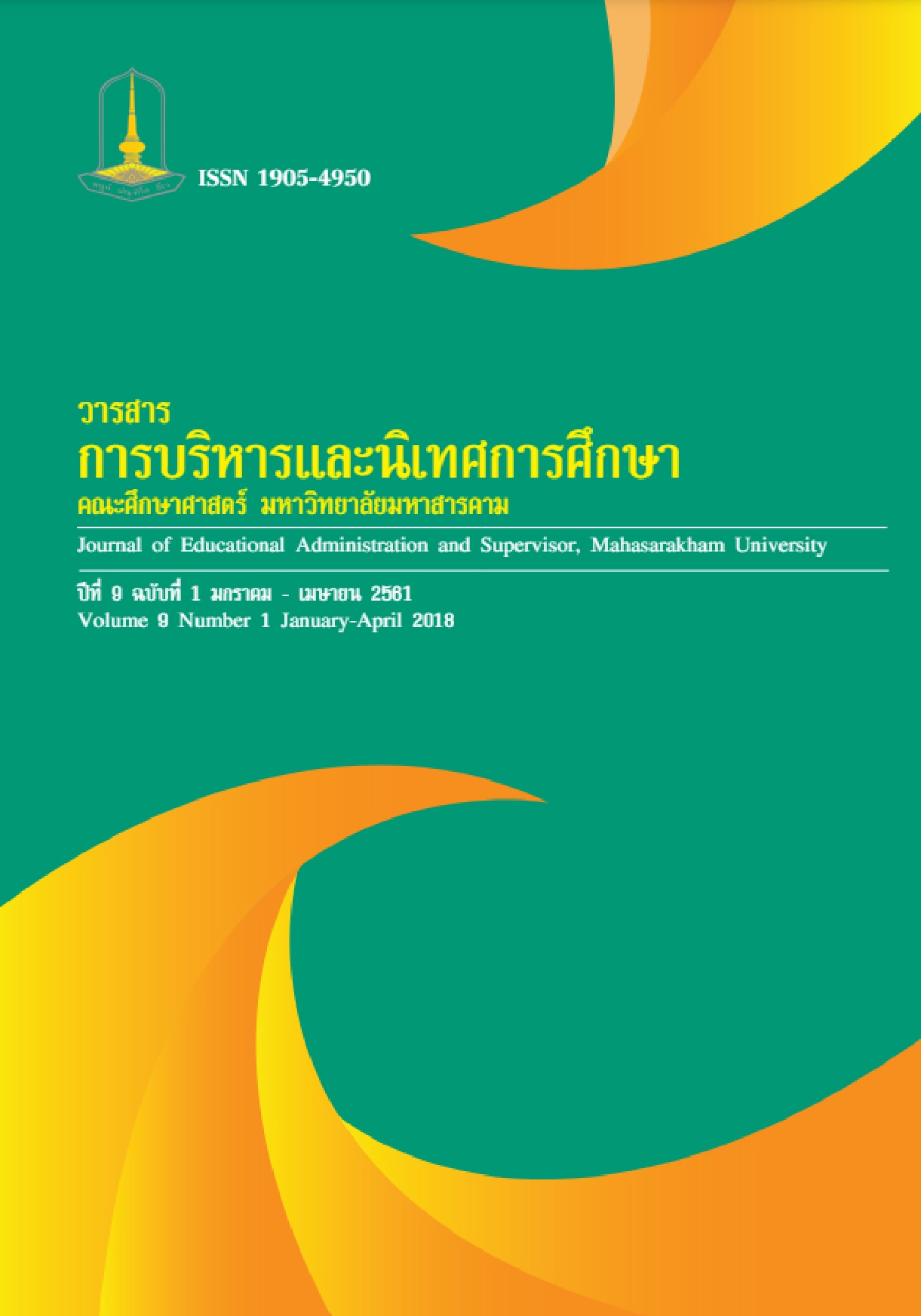Guidelines of Supervision by Mentoring at Schools Under the Office of the Secondary Education Service Area 30
Main Article Content
Abstract
This research aimed to 1) Study of current and desirable situation, 2) To develop an internal supervision model for school administrators. Under the Office of the Secondary Education Service Area 30 This research was divided into 2 periods. Phase 1. The problems of internal supervision.In the school Under the Office of the Secondary Education Service Area 30. The study was divided into 2 phases. 1) The sample consisted of 393 administrators, teachers and administrators of schools. Step 2: Current condition study Problems and Solutions of Internal Mentorship Supervision for Educational Institution as School Supervision Model The data were collected from 9 informants. Phase 2 Development of internal mentoring guidelines for school administrators under the jurisdiction of the Office of the Secondary Educational Service Area 30, who provided information to answer the questionnaires on the appropriateness and feasibility of the internal supervision guideline in schools under the jurisdiction of the district office. Secondary Education Area 30 includes 20 school administrators and those responsible for internal supervision. 20 people totaled 40 persons. The instruments used in the research were statistical data analysis for the data analysis, ie, percentage, mean and standard deviation. The research found that.
This research found the following results.
1. Current conditions of internal supervision in the school. Under the jurisdiction of the Office of the Secondary Education Service Area 30, When considered on a case by case basis, it was found that there was moderate level in all 5 aspects. Sort the average of the first three to the first to expand the results and praise the honor. The implementation of supervision. And evaluating and reporting evaluation results. The items with the lowest mean scores were the supervision planning.
The problems of internal supervision in the school, When considering each side, it was found to be at the whole level. And moderate Sort by average to very low.The first three are the planning of supervision. Survey needs and necessities. And evaluating and reporting evaluation results. The items with the lowest average scores were internal supervision.
2. Internal Mentality Supervision in Schools under the jurisdiction of the Office of the Secondary Educational Service Area 30 found that the internal supervision guidelines in the educational institutions under the jurisdiction of the Office of the Secondary Educational Service Area were consisted of five aspects, namely, survey, needs and necessity. The planning of supervision. The implementation of supervision. Evaluation and monitoring reports and the extension of praise and glory. And the results of the suitability assessment and the feasibility study showed that. The right side is that. Overall, it was found to be at the highest level in terms of It is possible experts have commented that. Overall, the possibilities are high and the results of the evaluation of the internal supervision guideline in the schools under the jurisdiction of the Office of Educational Service Area 30 were found that the school administrators and the head of the learning group had a good opinion of the manual. The overall level is very high. And the possibilities of the manual as a whole are very high.
Downloads
Article Details
References
จิณหธาน์ อุปาทัง. (2551). การศึกษาการดาเนินงานนิเทศภายในของโรงเรียนที่ได้รับการรับรองมาตรฐานการศึกษา สังกัดสานักงานเขตพื้นที่การศึกษากรุงเทพมหานคร. วิทยานิพนธ์ ค.ม. กรุงเทพฯ: จุฬาลงกรณ์มหาวิทยาลัย.
บุญชม ศรีสะอาด. (2545). การวิจัยเบื้องต้น. พิมพ์ครั้งที่ 7. กรุงเทพฯ: สุวีริยสาส์น.
พัชรินทร์ ช่วยศิริ. (2554). การศึกษาการดาเนินงานนิเทศภายในของโรงเรียนวัดประดู่ฉิมพลี. สารนิพนธ์ กศ.ม. กรุงเทพฯ: มหาวิทยาลัยศรีนครินทรวิโรฒ.
พิบูลชัย ศรีเข้ม. (2553). การศึกษาสภาพและปัญหาการนิเทศภายในสถานศึกษา สังกัดเทศบาล เขตการศึกษา 10. วิทยานิพนธ์ ค.ม. อุบลราชธานี: มหาวิทยาลัยราชภัฎอุบลราชธานี.
วไลรัตน์ บุญสวัสดิ์. (2538). หลักการนิเทศการศึกษา. กรุงเทพฯ: ภาควิชาการบริหารการศึกษา คณะคุรุศาสตร์ จุฬาลงกรณ์มหาวิทยาลัย.
วัชรา เล่าเรียนดี. (2548). การนิเทศการสอน. นครปฐม:โรงพิมพ์มหาวิทยาลัยศิลปากร.
สุภาภรณ์ กิตติรัชดานนท์. (2551). การพัฒนารูปแบบการนิเทศการจัดการเรียนการสอนในสถานศึกษาขั้นพื้นฐาน. วิทยานิพนธ์ กศ.ด. มหาวิทยาลัยนเรศวร.
สํานักงานคณะกรรมการการศึกษาขั้นพื้นฐาน. (2552). การนิเทศเพื่อพัฒนาโรงเรียนมัธยมศึกษา. กรุงเทพฯ: บริษทักรีนกรุปจํากัด.
สานักงานคณะกรรมการการศึกษาขั้นพื้นฐาน. (2555). ํ การพัฒนากระบวนการนิเทศภายในสถานศึกษาสู่วิธีการปฏิบัติ. กรุงเทพฯ.
สำนักงานคณะกรรมการการศึกษาแห่งชาติ. (2542). การกำกับติดตาม/นิเทศและประเมิลผลการนิเทศโรงเรียนประถมศึกษา. กรุงเทพฯ: โรงพิมพ์คุรุสภา.
โสภณ ทองจิตร. (2553). การปฏิบัติตามกระบวนการนิเทศภายในของผู้นิเทศการศึกษา ในโรงเรียนเครือข่ายบางกุ้ง จังหวัดสุราษฎร์ธานี. ภาคนิพนธ์ ค.ม. มหาวิทยาลัยราชภัฏสุราษฏร์ธานี.
อุทัย บุญประเสริฐ. (2536). หลักการแนะแนวทางในการจัดการนิเทศภายในสำหรับสถานศึกษาประถมศึกษา. กรุงเทพฯ: รุ่งสาส์นการพิมพ์.
Anderson, Eugene M. and Anna L. Shannon. (2002). “Toward a Conceptualizing Of Mentoring,” Journal of Teacher Education. 39(1): 38-42 ; January.
Marlene, P and M. Jana. Machenry. (2002). “The Mentor’s Handbook: Practical Suggestions For Collaborative Reflection and Analysis,” Christopher-Gordon, 3(1): 152 ; January.
Mentor International Study Consultant. (2009). Chapter Three: What Are the Step for Developing and Implement Mentoring. 23 June.
Rahman, T. and others. (2005). “A Systemic Mentoring Model in Computer Science,” Annual Southeast Regional Conference. 18(20): 371 - 375 ; March.
Rolando, Cruz. (2009). Different Leadership Style Definition. <http://www.essortment.com/liftstyle/different leader skus. htm.
Sweeny, Barry W. (2008). Defining the Distinctions Between Mentoring and Coaching. 15 October, 2009.
Young, Paul G. and others. (1950). Mentoring Principle: Framework, agendas, tips, and Case Stories for Mentors and Mantes. USA: Sage Publication Ltd.


